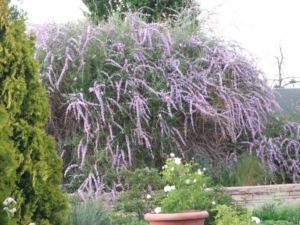
Finding Inspiration
by Sandy Swegel
I’ve been going to our local (and extraordinary) botanic gardens, The Denver Botanic Gardens, DBG, every two weeks this year. Every year I intend to go but get busy and only get there once or so. But I bought a family membership that included six tickets per visit….so now I’m getting to see the gardens and making new friends every time because I invite all kinds of people so I don’t “waste” the tickets. Even though I’m a professional gardener and am in other people’s landscapes all the time, I am learning so much. I encourage you to go with observant eyes and watch how public gardens are designed and managed. (On the weeks I don’t go to the DBG, I take a hike in the nearby foothills to see how Mother Nature designs and manages gardens. She’s a bit messier.)
Some of the things I’ve learned this last week:
Plants want to Mingle. Although DBG tags its plants so we know what is what, they aren’t really a single specimen sitting alone…all the plants grow next to one another and through each others’ branches and leaves. A tall flower that falls doesn’t need to be staked right away…it starts to grow up toward the light from its down position and still looks great growing out of the groundcover. Trees and giant viburnums are all artfully pruned so they send long arms through each other, never having to stand alone. Old trees keep their place, but new ones of a different variety are planted nearby. The old one’s broken trunk and nasty gashes are covered and the new tree doesn’t look so scraggly.
The same plant can look so different in another setting. The DBG has a policy of gentle tolerance toward reseeding plants. As long as they look good and aren’t choking out other plants, the repetition of salvia or verbena from one display garden to another gives a feeling of unity to the entire area.

Photo by Sandy Swegel
Giant plants look great at the periphery. Giant shrub viburnums or 15-foot tall lilacs or this massive Buddleja alternifolia ‘Argentea’ planted along the far back of a garden area are stately and give a sense of structure and enclosure to a garden. Some of the nearby trees seem small in comparison. But a garden full of small plants can look like just a lot of little things that are hard to distinguish from one another.
Use more Art and Light and Water. Sculptural pieces of art, strategically placed solar lights, and even very small water features turn a garden from beautiful into delightful! As dusk descends on the Denver Botanic Gardens, strands of lights and solitary spotlights come on turning what was a lovely day into a magical evening.
Tour your local Botanic Garden soon. You’ll find like I did, the inspiration for dozens of ways to do things differently in your garden.
http://www.botanicgardens.org/
Photo credits: Sandy Swegel



